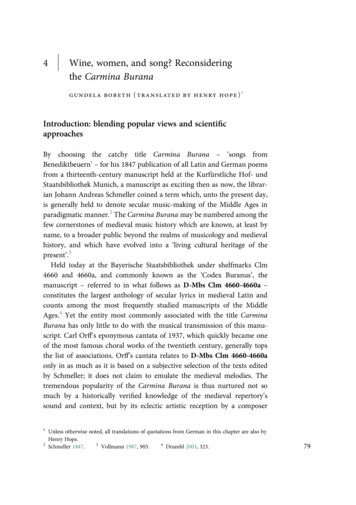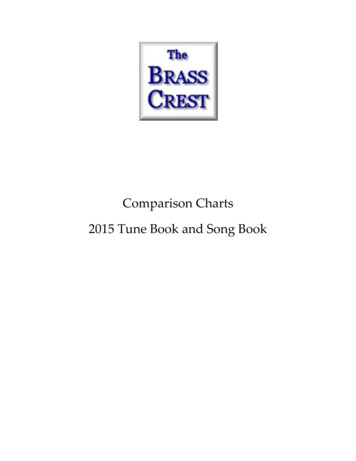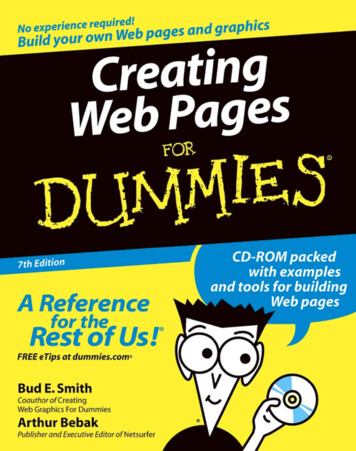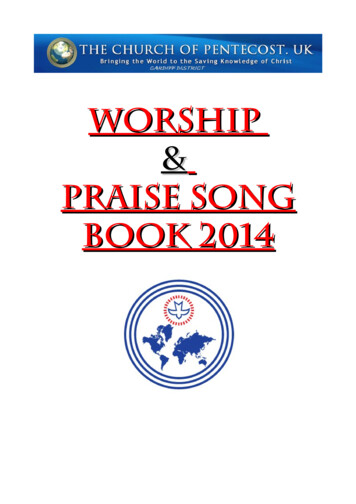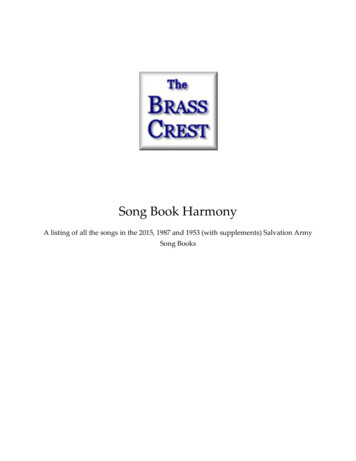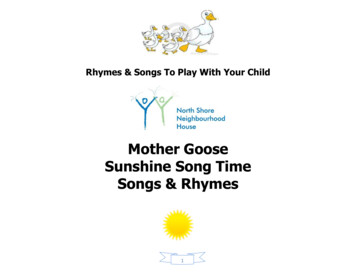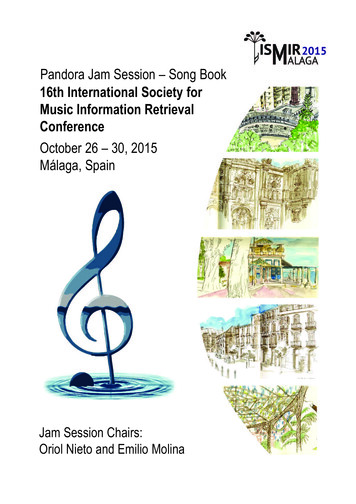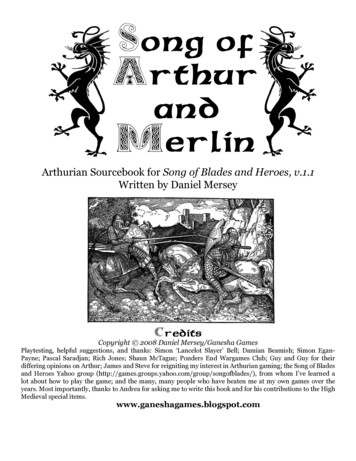
Transcription
Song ofArthurandMerlinArthurian Sourcebook for Song of Blades and Heroes, v.1.1Written by Daniel MerseyCreditsCopyright 2008 Daniel Mersey/Ganesha GamesPlaytesting, helpful suggestions, and thanks: Simon ‘Lancelot Slayer’ Bell; Damian Beamish; Simon EganPayne; Pascal Saradjan; Rich Jones; Shaun McTague; Ponders End Wargames Club; Guy and Guy for theirdiffering opinions on Arthur; James and Steve for reigniting my interest in Arthurian gaming; the Song of Bladesand Heroes Yahoo group ), from whom I’ve learned alot about how to play the game; and the many, many people who have beaten me at my own games over theyears. Most importantly, thanks to Andrea for asking me to write this book and for his contributions to the HighMedieval special items.www.ganeshagames.blogspot.com
Table of ContentsIntroduction3Special ScenariosPage ReferencesDrawing the Sword from the StoneWhich King Arthur to Play The Strife of CamlannGrail Quest CampaignWithin Camelot’s HinterlandInto the Perilous ForestThe Desolate DesertSpecial Rules4The Grail CastleBardFinding the GrailChivalryGrail TestsDogged5Hero’s HorseThe Welsh King BackgroundInconvenientSpecial ItemsJousterArthur’s MantleKnight6Arthur’s WeaponsLegendary WizardCauldron of CeridwenProtect7Cauldron of ChampionsSolar ForceDart of True FlightStubbornEnchanted WeaponUniqueFaerie CloakSpecial SituationsLion-Skin ShieldHerdsMagical TorcJoustingMeadRaiding8Padarn’s TunicPendragon’s HelmetThe High Medieval King Background9Prydery and Manawyddan’s ShieldsSpecial ItemsRydderch Hael’s SwordThe Adventurous ShieldStanding StonesBalin’s BroadswordTerrifying War HornBlessed ArmorTudwal Tudelud’s WhetstoneBor’s Sword10Weasel VenomDamsel’s RibbonWarbandsExcaliburDesigning Your WarbandGalatineTriad TaleGolden HarnessWelsh King Warband AdvancesThe GrailBefriended by EaglesHermit’s Potion11Druid’s FavorLancelot’s RingHost of RidersMagical RingKnowledge of FolklorePerceval’s SwordMeadPriamus’ SwordRaven FeedersRelic SwordRustlersSacred VisionSailing to AvalonThe Spear of VengeanceShapechangerTerror TreeWelsh King RostersViviane’s Shields12Water of ParadiseWarbandsDesigning your WarbandGames Between Bands of KnightsQuesting Knights13High Medieval Warband AdvancesChampion’s ChallengeKnights of the Round TableKnowledge of FolkloreSailing to AvalonValorousHigh Medieval Rosters14Scenario Generator16None Shall Pass!Blood Feud17RescueTournament 181920212223Scenario GeneratorKill the Monster!Magical Cattle RaidKidnapThe HuntCulhwch and Olwen CampaignWrnach the Giant’s SwordThe Cauldron of DiwrnachThe Hunt for the Giant BoarThe Very Black Witch272829The Historical King Background30Designing Your WarbandWarband AdvancesAngonsBoar’s SnoutFlags and HornsHost of RidersRoman EquipmentRustlersSea RaiderShieldwall VeteransSuccessor31Historical King RostersDismounting Chieftains and Champions 33Scenario Generator34RaidMaraudersFight at the FordSpecial Scenarios: the Fifth Century ADThe Battle of BadonGroups in Historical Games35Zone of ControlThe Ride of the Gododdin24Designer’s NotesMiniature Lists and Further Reading2536
IntroductionThis is an Arthurian sourcebook for Song ofBlades and Heroes, rather than a new set ofstand-alone rules. You’ll need to refer back to theoriginal rulebook, Song of Gold and Darkness andSong of Wind and Water to learn the game andidentify most special rules and some rosters usedin this supplement. The special rules, objects,terrain, and game mechanisms outlined in SBHand other supplements are usable with this bookif you wish to expand your Arthurian setting.Each section of this book contains new items andwarband advances relevant to three differentArthurian worlds; feel free to include these ideasin non-Arthurian games. Rosters include modelsfrom previous supplements where applicable tothe Arthurian setting; this is to clearly indicatewhat models most suit an Arthurian setting. Ifyou fancy introducing other monsters, that’s fineso long as your gaming pals agree.Page ReferencesTo prevent repetition of rules, references to preexisting rules are noted as SBH (Song of Bladesand Heroes), SGD (Song of Gold and Darkness),or SWW (Song of Wind and Water) followedby the page number in that book. Referencesincluding a page number only are references tothis book.Which King Arthur to Play?Stories of Arthur have been around for manygenerations, maybe from as early as the sixthcentury and definitely from the ninth century,intertwining many different settings andcharacters. Depending on your take on the legendor history, you may decide to play games set inthe classic Arthurian setting of an enchantedmedieval world (High Medieval King), or preferthe equally enchanted but slightly grittier settingof earlier Celtic folklore and old school history(Welsh King). Some players wish to re-enact thereal life battles in Britain of the fifth and sixthcenturies – the historical era in which a real lifeArthur might have lived – bereft of magic andmonsters, but still full of tactical choices andtough warbands (Historical King).The same miniatures can be used for the Welshand Historical King games, using models fromthe many existing Dark Ages ranges; for HighMedieval games, look to plunder fantasy rangesand historical models from the medieval period1100-1500.
Arthurian Special RulesStandard Chivalry ChartBardAs one action, a Bard may temporarily make anyone friendly model within Medium distance intoa Hero during that model’s next turn. The targetmodel may be changed each turn, but a Bard mayonly make one Hero per turn. If a Bard uses thispower on a model with the Hero special rule, thathero receives two automatic successes. A Bard isa Personality model.ChivalryA Chivalry rating is given to any model with theKnight special rule – wizards, brigands, peasants,and creatures don’t live their lives by a chivalrouscode of honor. Chivalry reflects the heroic or evildeeds a knight accomplishes, judged against thestandards of the Round Table. Chivalry is notaffected by Morale; a negative score represents arogue or evil knight rather than a coward.All knights begin with a Chivalry of 0, but maycarry over their Chivalry score from game togame. Every time a model performs a good act ora bad act in the game, they add or subtract pointsof Chivalry (this is one of the few bits of recordkeeping you’ll need in the game – and if you’replaying one off scenarios, you can leave this ruleout). The Standard Chivalry Chart shows whatconstitutes a good or bad act. Some scenarios’Victory Conditions allow the player to choosewhether to take positive or negative Chivalry,depending on which is most beneficial to themodels in his warband.Good ?As specified by scenario or agreed byplayers in game (awarded at end ofgame) 1Moving to fight enemy with higherCombat rating (each time the modelmoves into hand to hand) 1Not striking at an opponent who hasFallen Down when the opportunity arises(each time) 1Unhorsing an opponent in a joust (onceper opponent) 1Backing out of a combat so that opponentis no longer outnumbered (each time) 1Slaying a model with the Terror specialrule (once per slaying)Bad-?As specified by scenario or agreed byplayers in game (awarded at end ofgame)-1Killing opponent who has Fallen Down(once per opponent)-1Using a missile weapon (each time)-1Using an Ambush (each time)-1Using poison or spells – but not usingmagic weapons or armor (each time)-1Joining a fight where the enemy isalready outnumbered (each time)When a model attains certain Chivalry points,the warband may go on a Quest scenario to find aSpecial item of the player’s choosing; see SpecialItems in the High Medieval King section for moredetails.
InconvenientGiven the epic nature of the Arthurian setting,you might wish to make your campaigns longerthan the usual 4-5 games when using the Chivalryrules – the longer your campaign, the greateryour chance of questing for some seriously goodspecial items.Chivalry costs no extra points.A player spends points on this model as usualand may choose to place it in his opponent’swarband rather than his own (at no points costto the opponent). The model becomes partof the opponent’s warband for the entirety ofthe scenario, and one Knight on that warband(nominated by the Knight’s owning player) gainsthe Protect special rule for the Inconvenientmodel, for 0 points. Only one Inconvenient modelmay be given to an opponent in any scenario.DoggedOnce entering into combat with an opponent, themodel cannot leave that combat or start a fightwith a new opponent until his current enemy hasbeen killed or fled from the table. Other modelsmay join the fight, but the original opponentmust remain the Dogged model’s target on hisown attacks. If the original opponent breaks offcombat, the Dogged model must pursue until theopponent is dead or off the table.Example: Simon chooses to add an Inconvenientdamsel to his warband for 8 points, so that hecan place her in his opponent’s warband beforeeither warband deploys on the table. This meansthat his total points value is now 292 comparedto his opponent’s 308 – although both still countas their original 300 points in game terms.Hero’s HorseHis opponent, Damian, has several Knights in hiswarband, so must now select one of these modelsto Protect the damsel (at 0 points cost). Damiandeploys and controls the Inconvenient modelthroughout this game, but will hand the modelback to Simon when the game has ended. Duringthe game, Simon gains Victory Points for killingthe Inconvenient damsel, Damian’s Knight mustabide by the Protect rules and if the Inconvenientmodel is killed, her loss counts for Morale andother game purposes against Damian.Any model with this rule may choose to beMounted on a horse (Long Move) at the start ofthe scenario.Designer’s note:Purchasing an Inconvenient model and placingit in your opponent’s warband means that youropponent will need to keep that figure out ofdanger or potentially risk the Morale test causedby a gruesome death. In non-Arthurian settings,the model needing to Protect the Inconvenientmodel may be either a Knight or a Personality.JousterWhen jousting on horseback, the model may addan additional 1 to his Combat score.
Knightcast a normal spell as detailed in SBH (pages9-10), and being a Legendary Wizard he maydouble the distance of effect, or he may choose touse one of his special powers. Deciding that thelatter would be more useful in this turn, he flickshis fingers and magically increases the size of hisnearby friend Gawain, making him Big for thisone turn (Gawain is within Long distance). Atthe start of the following turn, Gawain loses theBig rule. When Merlin is next activated, he rollsonly two successes, so may only cast a Power 1or 2 spell if using magic (but is able to do so overdouble the normal distance). Next time Merlinrolls three successes, he might cast a normalpower 3 spell, or again choose to make GawainBig, or choose to fly himself elsewhere, make hisenemy Mordred Greedy for one turn, or createan aura of Terror around Arthur for one turn– so long as the spell is cast on Merlin himselfor a model within long distance of him. Yourchoices are plentiful when you are a LegendaryWizard!Designer’s note: This rule gives the user a widervariety of spells to cast, but doesn’t requireplayers to learn lots of new rules. Cost-wise,this is expensive we calculated its cost of 99points adding up to all the special rules that canbe cast, halved to reflect the random dice rollingaspect of using them.There are some things in the game that only aKnight character can do (such as joust, have aChivalry score, or Protect an Inconvenient model).This special ability may not be given to Animals,Magic users, or monsters (unless specified ontheir roster). A knight may be mounted usingHero’s Horse and take Heavy Armor rule as anupgrade, at the normal cost for these rules.Legendary WizardThis special rule gives the model the Magic-Userrule, with more powerful spell casting ability.The distance that a spell (including Transfix)may be cast over is doubled (Power 1 becomes2x Short, Power 2 becomes 2x Medium, Power 3becomes 2x Long).In addition, as a Power 3 spell,the model may cast any of the following specialrules to affect himself, or a friend or an enemywithin Long range. The effect of this lasts only forone turn, but the Legendary Wizard may cast thesame spell on the same model in as many turnsas he wishes. If the target model is an opponent,that model makes a standard magic resistance rollagainst power 3 to prevent the effect (see SBH).The spell is chosen from the following list ofspecial rules:Amphibious,Berserk,Combat Master,Danger Sense,Desert Walk,Distract,Flying,Greedy,Heavy Armor,Size (this increases the user’s or target model’ssize from normal to Big, or from Big to Huge),Slow,Snow Walk,Stealth,Swamp Walk,Teleport,Terror (the target model gains this rule).Example: Merlin, a Legendary Wizard, isactivated with three successes. Choosing to usethem all to create a Power 3 spell, he may either
Special SituationsProtectA model with this special rule must remainwithin a Long move of a named companion forthe entirety of the game if both models are in thesame warband. If this rule is ever broken, themodel must attempt to move back within thisdistance as soon as possible. If the model beingprotected is killed or is removed due to a Moraletest, the protector immediately gains the Doggedspecial rule against the slayer. If the protectedmodel flees off the table, protection becomes voidfor the rest of the scenario.HerdsHerds are used in raiding games (see Raiding, p8).A herd may be any domesticated animal, or evenhumans who are taken as slaves. Herds are basedon stands the same size as mounted models.Solar ForceSome models abilities are stronger or weakeraccording to the sun’s power. To find the time ofday at the start of the game, roll 1d6 to discoverthe sun’s effect on this model: on a score of 1-2,modify 1 Quality and -1 Combat; on a s
-1 Using poison or spells – but not using magic weapons or armor (each time)-1 Joining a fight where the enemy is already outnumbered (each time) When a model attains certain Chivalry points, the warband may go on a Quest scenario to find a Special item of the player’s choosing; see Special Items in the High Medieval King section for more details. Given the epic nature of the Arthurian .
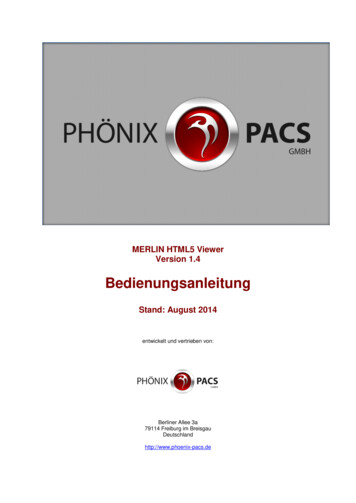
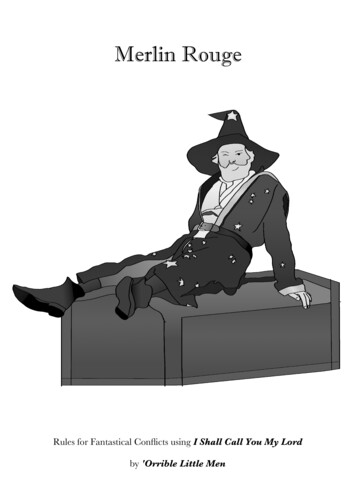
![Merlin@home Transmitter [RF] [symbol update] [RED comp .](/img/10/7bd6c35e-42f6-4c21-be52-037b05000831.jpg)
